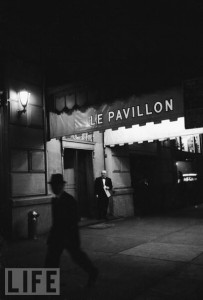August 11th, 2011 § § permalink
HG is skeptical about most received wisdom and belief. HG looks askance at wise financial planners, passionate religious types of all denominations, declaimers of national virtues and realtors who assure the unwary that the value of their home will continue to rise. HG’s contrarian nature took birth at Toffenetti’s Restaurant, a dining palace of glass and chrome that fed the masses at 43rd and Broadway in Times Square (there were also six Toffenetti dining places in Chicago).
The founder, Dario Toffenetti, was a master of rococo, hallucinatory menu prose. Ham was described as “velvety”, the product of aristocratic, pampered hogs. A baked potato wasn’t a simple spud. It was “baked in volcanic heat to give it a crisp and crackling skin.” Sounds good, doesn’t it? Well, HG was absolutely lured by the prose. Sadly, The menu was pure poetry and the food was prosaic. Much was too sweet to be edible. And no, those potatoes did not crackle, they wilted with mediocrity.
HG learned from the experience to not to be influenced by the artistry and wiles of the advertising and public relations community (even though HG made a substantial living during some 60 years of practicing high grade press agentry). Toffenetti had a long run: 1940-1968. At the end it introduced (to great fanfare!) an all-you-can-eat repast for $3.49. Nothing poetic about that.
$3.49.
July 30th, 2011 § § permalink
At one point in the distant past, HG collaborated with the distinguished advertising copy writer Charles Ewell on a television project. (Ewell had many distinctions. He headed Volkswagen’s advertising creative team in Germany and played on a Columbia University football team with Jack Kerouac). HG and Charlie would take a break from their lofty endeavors and visit a Chinese restaurant on Seventh Avenue just west of 57th Street. And what did these discerning gentlemen order? Did they dive deep into the mysteries and subtle refinement of authentic Cantonese cuisine? Nope. Combo platters. That’s right. They ordered large platters containing a greasy egg roll, corn starchy shrimp Chop Suey and dark brown pork fried rice. Much hot mustard was applied. Final disgraceful touch: Dabs of very sweet plum sauce on the egg roll and fried rice.
HG blushes with shame at the memory. But, it sure tasted good.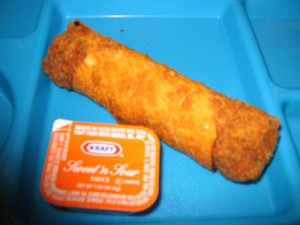
July 3rd, 2011 § § permalink
 Thoughts of ice cold borscht and steamy New York weather make HG recall those refuges from the heat: Dairy restaurants. Dairy restaurants obeyed Jewish dietary laws and served only “dairy” and “pavre” food.
Thoughts of ice cold borscht and steamy New York weather make HG recall those refuges from the heat: Dairy restaurants. Dairy restaurants obeyed Jewish dietary laws and served only “dairy” and “pavre” food.
They served borscht (beet soup), schav (sorrel soup), blintzes (rolled crepes stuffed with cheese or potato) , kasha varnishkes (buckwheat groats with butterfly shaped pasta), potato pirogen (boiled potato and onion dumplings) and more. Big bowls of excellent bread, bialys, onion rolls — also called “pletzels” and copious amounts of butter. Big bowls of thick sour cream were there on the table to accompany every dish. There was fish (considered “parve” a.k.a. neutral meaning neither meat nor dairy) including many varieties of herring; tuna and sardine salads; gefilte fish with strong horse radish.
No meat. Emphatically no meat. Forbidden. A kosher enterprise could not serve both meat and dairy products.
Every Manhattan neighborhood had a Dairy restaurant (okay, not the Upper East Side). The Paradise and Steinberg’s were popular on the West Side. Ratner’s and Rappaport’s ruled the Lower East Side. Scores more in The Bronx and Brooklyn. All gone. Assimilation or changing tastes?
SJ reports only one traditional “Dairy” remains: B&H on Second Avenue. Long may it cool fevered brows and clog arteries.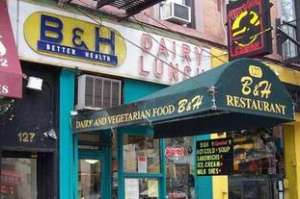
June 29th, 2011 § § permalink
Christ Cella was a New York steak house on East 44th that was a lure for athletes and big eaters. At lunch one day, HG spotted the late Howard Cosell, boxing promoter Don King (of the electric hair) and that deadly jump shooter, Jerry West. HG stopped at West’s table and told him he was forgiven for all the bad things he did to the Knicks. Jerry was amused.
HG always had the same two meals at Christ Cella. In the fall and winter (HG did not dine there in summer, preferring lighter victuals): A scotch sour (freshly squeezed lemon juice); lobster cocktail with Remoulade sauce; New York strip steak (Christ Cella had the all time beefiest, best and biggest steaks in the civilized world) accompanied by salad with Roquefort dressing. Beverage was black and tan (Ballantine India Pale Ale mixed with Guiness Stout—half and half).
In spring HG replaced the steak with a platter of grilled shad, shad roe, bacon, home fried potatoes, sharp tartar sauce and cole slaw. HG never had dessert. Heartier souls knocked off giant portions of New York cheesecake. The admen in the restaurant preceded their meal with two or three martinis.
Yes, indeed, happy drunken high cholesterol days. Those martini drinking, cigarette puffing guys are, of course, a memory like Christ Cella itself.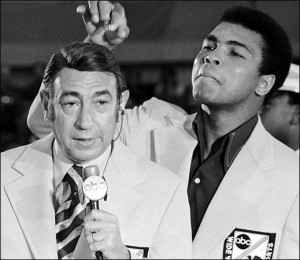
June 27th, 2011 § § permalink
While New York is still chock full of great seafood restaurant there are four (now shuttered) that HG still pines for.
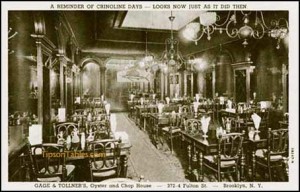 1. Gage and Tollner in downtown Brooklyn. One of the oldest restaurants in New York City, this was a hangout for aristocratic old families of Brooklyn Heights. Entirely illuminated by gas lighting, the untouched turn of the century decor was just wonderful. Dignified, African-American waiters. The sleeves of their jackets had stripes denoting years of service. Average was 25 years. Best dishes: Sauteed clam bellies. Shad and shad roe (in season). Clams and oysters on the half shell. There was also a meat dish fancied by HG: A big, rare (Juicy and gamy) mutton chop accompanied by corn fritters.
1. Gage and Tollner in downtown Brooklyn. One of the oldest restaurants in New York City, this was a hangout for aristocratic old families of Brooklyn Heights. Entirely illuminated by gas lighting, the untouched turn of the century decor was just wonderful. Dignified, African-American waiters. The sleeves of their jackets had stripes denoting years of service. Average was 25 years. Best dishes: Sauteed clam bellies. Shad and shad roe (in season). Clams and oysters on the half shell. There was also a meat dish fancied by HG: A big, rare (Juicy and gamy) mutton chop accompanied by corn fritters.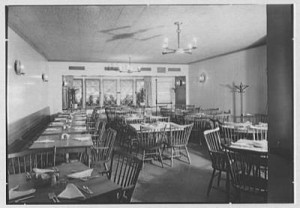
2. Gloucester House in the East 50’s. Chaste New England decor. Very expensive. Clientele: Rich Park Avenue types and publishing biggies. HG often saw Helen Gurley Brown (One time Editor of Cosmopolitan Magazine, author of Sex and the Single Girl and longtime advocate of sexual liberation) and her film producer husband David Brown (“Jaws”, “The Sting.” etc.). Best Dishes: Broiled lobster. Lobster Newburg. Potatoes au gratin. Fried onion rings. Swordfish.
3. Seafood of the Aegean in the East 50’s. Decor: Stylish, yet Greek (hard to imagine, well…just try!). Clientele: Madison Avenue advertising executives. Best dishes: a lemony Avoglemono soup. Shrimp Santorini — Jumbo shrimp with grilled whole tomatoes, tomato sauce and sharp feta cheese — served bubbling hot.
4. Sweets located on the East River waterfront near Wall Street. Decor: Very austere, no frills. Crusty, bad tempered old waiters. Clientele: Wall Streeters and the coffee, tea and cocoa importers that were HQ’d on Water Street. Best dishes: The very best and freshest simply broiled and sauteed fish; clams, oysters, lobsters and crabs—all purchased that morning from the nearby Fulton Street Fish Market.
Anchors Aweigh, Indeed.
June 25th, 2011 § § permalink
Rockaway was the proletarian barrier beach (between the Atlantic Ocean and Jamaica Bay) where HG and millions of sweltering New Yorkers escaped the summer blaze in years gone by. During the 70s, 80s and 90s, drug violence and the proximity to some fairly dangerous public housing lessened its attractiveness. But, Rockaway has re-surfaced with a sudden cache of cool. It started with a movement of urban surfers, who did not care that Rockaway’s waves were not California size, they were NYC waves and that was cool enough. They carried their surf boards on the subway and soon Williamsburg hipsters and lots of other cool folks from Brooklyn and Manhattan wanted to see what was going on. (Rockaway is reached by a comparatively short subway ride).
And, where there are hipsters, there’s hip food and drink. The New York Times has been reporting on the opening of many good, casual ethnic dining spots along the Rockaway Boardwalk.
HG suggests it may be time to revive that great beach classic –The Takee Cup. HG wistfully recalled the tasty Takee Cup in a post a few months ago. Bring it back for the new cool generation.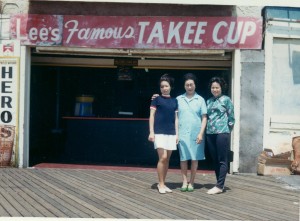
June 23rd, 2011 § § permalink
 Frank Sinatra loved it. So did Jason Robards and David Mamet (who wrote about it in his book of essays Make Believe Town: Essays and Remembrances. Sidney Poitier dined there often when he was appearing on Broadway. Coleen Dewhurst called it “family.” HG is referring to Delsomma, an Italian restaurant at 266 W. 47th Street in the heart of the theater district. It closed in 1993, a victim of the drug dealing, prostitution and street violence that plagued 8th Avenue and surrounding side streets in the late 80’s and early 90’s. Run by the Cardinale family for 40 years, every diner was treated like a star. HG and BSK were introduced to Delsomma by their dear friend, the late Michael Small. Michael, who composed the score for many memorable films, took them there after the premiere of Marathon Man (with Dustin Hoffman and Lawrence Olivier playing a Nazi dentist). Michael did the chilling score.
Frank Sinatra loved it. So did Jason Robards and David Mamet (who wrote about it in his book of essays Make Believe Town: Essays and Remembrances. Sidney Poitier dined there often when he was appearing on Broadway. Coleen Dewhurst called it “family.” HG is referring to Delsomma, an Italian restaurant at 266 W. 47th Street in the heart of the theater district. It closed in 1993, a victim of the drug dealing, prostitution and street violence that plagued 8th Avenue and surrounding side streets in the late 80’s and early 90’s. Run by the Cardinale family for 40 years, every diner was treated like a star. HG and BSK were introduced to Delsomma by their dear friend, the late Michael Small. Michael, who composed the score for many memorable films, took them there after the premiere of Marathon Man (with Dustin Hoffman and Lawrence Olivier playing a Nazi dentist). Michael did the chilling score.
From that time forward it became HG and BSK’s go to place for Italian food. Their first meeting with Profesore/ Dottore M. (yet to become the husband of daughter LR) was at Delsomma. The fastidious (and nervous) M. heartily approved of the food. Some of the house specialties: Ziti with broccoli, lightly fried jumbo shrimp in lemon sauce, pork chops with vinegar peppers—and some of the best veal in town. Beautiful potato croquettes. Sauteed escarole with garlic. Michael Small and Delsomma are always linked in HG’s memory. Miss them both.
June 22nd, 2011 § § permalink
The best American food in New York used to be served by an elegant Greek gentleman, Leon Lianides at his Coach House Restaurant at 110 Waverly Place in Greenwich Village. The restaurant closed in 1993 (the site is now occupied by Mario Batali’s Babbo, an excellent restaurant that introduced a new type of Italian cuisine).
Upon being seated at Coach House, diners were served warm corn sticks. Celestial cornbread. Perfect accompaniment to the black bean soup (which was enriched by a hint of Madeira). There were wonderful crab cakes. Just juicy hunks of the best Chesapeake lump crab meat held together by the merest bit of bread crumbs and seasoning. Lamb ruled at Coach House in the form of triple thick lamb chops or racks of lamb. Greedy HG always had dessert: Pecan pie (not too sweet) that had the right proportion of whole pecans and filling.
Mr. Lianides did not forsake his Greek heritage. He sometimes offered chosen customers (like HG) a taste of Tarama Salata, the salty Greek fish spread to accompany their icy pre-dinner Martini (click here for a link to Leon’s recipe for that Tarama Salata). He also gave HG an excellent cooking tip: Cut away every scrap of fat from lamb chops or lamb racks before roasting or broiling. Lamb fat does not enhance flavor. HG agrees…(SJ does not!)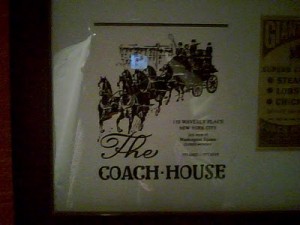
June 20th, 2011 § § permalink
Bo-Bo was a tiny restaurant located on Pell Street in New York’s Chinatown. No reservations. Often there was a 45 minute wait. Well worth it.
HG has forgotten the details of some of Bo-Bo’s best dishes, but one stands out. HG and BSK always ordered (and savored!) a big lobster roll. No, it was not the popular, New England lobster-and-mayonnaise on a hot dog roll. This was a giant sized egg roll stuffed with big chunks of lobster. To die for, as the cliche has it.
Bo-Bo was the first of Esther Eng’s five Manhattan restaurants and it set a new standard for Chinese food in New York. Curiously, Esther Eng was not just an enterprising restaurateur, but a groundbreaking figure in Chinese cinema. From 1936 to 1949 she produced, distributed and directed nine features and gave Bruce Lee his first screen debut. One result of her incarnation as a cinematic auteur was that Bo-Bo was often adorned with gorgeous Chinese actresses. When she passed away in 1970, the New York Times’ obituary simply read: “Theatrical director, producer, restaurateur, a great lady.” 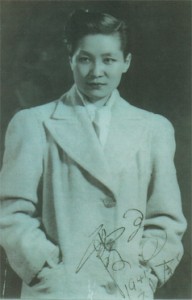
June 19th, 2011 § § permalink
Henri Soule’s Le Pavillon on 57th and Park in New York was the best restaurant in the world and HG has never seen it surpassed. The combination of Soule’s imperious attention to every detail, the great (and relatively simple) food, the comforting lighting, the glamorous crowd, the gentle and efficient service—-all created a joyous experience.
Some memorable dishes: Fillets of smoked eel topped with whipped cream infused with freshly grated horseradish. Duck with olives. Lump crab meat gratin. Souffle potatoes. Steak au poivre. Sweetbreads in puff pastry. Spring asparagus with Hollandaise. A simple grilled ribsteak with a cornucopia of wild mushrooms. Poule a Pot (which HG shared at lunch with labor mediator Theodore Kheel). Marrons au Mont Blanc (a mini mountain of pureed candied chestnuts topped with sweet, whipped cream).
Must stop. HG has tears in his eyes.